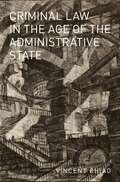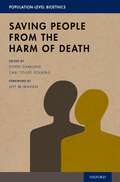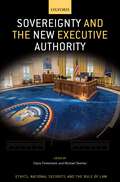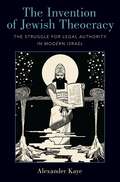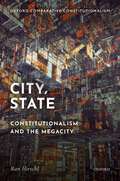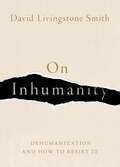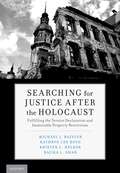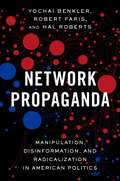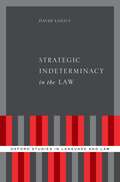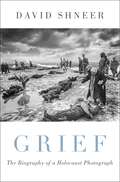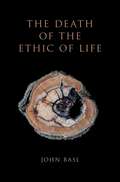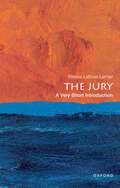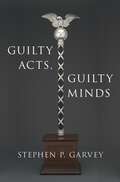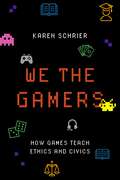- Table View
- List View
Criminal Law in the Age of the Administrative State (Studies in Penal Theory and Philosophy)
by Vincent ChiaoWhat is the criminal law for? One influential answer is that the criminal law vindicates pre-political rights and condemns wrongdoing. On this account, the criminal law has an intrinsic subject matter-certain types of moral wrongdoing-and it provides a distinctive response to that wrongdoing, namely condemnatory punishment. In Criminal Law in the Age of the Administrative State, Vincent Chiao offers an alternative, public law account. What the criminal law is for, Chiao suggests, is sustaining social cooperation with public institutions. Consequently, we only have reason to support the use of the criminal law insofar as its use is consistent with our reasons for valuing the social order established by those institutions. By starting with the political morality of public institutions rather than the interpersonal morality of private relationships, this account shows how the criminal law is continuous with the modern administrative and welfare state, and why it is answerable to the same political virtues. Chiao sketches a democratic egalitarian account of those virtues, one that is loosely consequentialist, egalitarian but not equalizing, and centered on a form of freedom-effective access to central capabilities-as its currency of evaluation. From this point of view, the role of the criminal law is to help public institutions create a society in which each person can lead a life as a peer among peers. Chiao shows how a democratic egalitarian approach to criminal justice provides a fresh perspective on a range of contemporary problems, from mass incarceration to overcriminalization, due process and the collateral consequences of a criminal conviction.
Saving People from the Harm of Death (Population-Level Bioethics)
Death is something we mourn or fear as the worst thing that could happen--whether the deaths of close ones, the deaths of strangers in reported accidents or tragedies, or our own. And yet, being dead is something that no one can experience and live to describe. This simple truth raises a host of difficult philosophical questions about the negativity surrounding our sense of death, and how and for whom exactly it is harmful. The question of whether death is bad has occupied philosophers for centuries, and the debate emerging in philosophical literature is referred to as the "badness of death." Are deaths primarily negative for the survivors, or does death also affect the deceased? What are the differences between death in fetal life, just after birth, or in adolescence? In order to properly evaluate deaths in global health, we must find answers to these questions. In this volume, leading philosophers, medical doctors, and economists discuss different views on how to evaluate death and its relevance for health policy. This includes theories about the harm of death and its connections to population-level bioethics. For example, one of the standard views in global health is that newborn deaths are among the worst types of death, yet stillbirths are neglected. This raises difficult questions about why birth is so significant, and several of the book's authors challenge this standard view. This is the first volume to connect philosophical discussions on the harm of death with discussions on population health, adjusting the ways in which death is evaluated. Changing these evaluations has consequences for how we prioritize different health programs that affect individuals at different ages, as well as how we understand inequality in health.
Saving People from the Harm of Death (Population-Level Bioethics)
by Espen Gamlund, Carl Tollef Solberg and Jeff McMahanDeath is something we mourn or fear as the worst thing that could happen--whether the deaths of close ones, the deaths of strangers in reported accidents or tragedies, or our own. And yet, being dead is something that no one can experience and live to describe. This simple truth raises a host of difficult philosophical questions about the negativity surrounding our sense of death, and how and for whom exactly it is harmful. The question of whether death is bad has occupied philosophers for centuries, and the debate emerging in philosophical literature is referred to as the "badness of death." Are deaths primarily negative for the survivors, or does death also affect the deceased? What are the differences between death in fetal life, just after birth, or in adolescence? In order to properly evaluate deaths in global health, we must find answers to these questions. In this volume, leading philosophers, medical doctors, and economists discuss different views on how to evaluate death and its relevance for health policy. This includes theories about the harm of death and its connections to population-level bioethics. For example, one of the standard views in global health is that newborn deaths are among the worst types of death, yet stillbirths are neglected. This raises difficult questions about why birth is so significant, and several of the book's authors challenge this standard view. This is the first volume to connect philosophical discussions on the harm of death with discussions on population health, adjusting the ways in which death is evaluated. Changing these evaluations has consequences for how we prioritize different health programs that affect individuals at different ages, as well as how we understand inequality in health.
Sovereignty and the New Executive Authority (Ethics, National Security, and the Rule of Law)
The idea of sovereignty and the debates that surround it are not merely of historical, academic, or legal interest: they are also potent, vibrant issues and as current and relevant as today's front page news in the United States and in other Western democracies. In the post- 9/11 United States, the growth of the national security state has resulted in a growing struggle to maintain the legal and ethical boundaries surrounding executive authority, boundaries that help to define and protect democratic governance. These post-9/11 developments and their effect on the scope of presidential power present hard questions and are fueling today's intense debates among political leaders, citizens, constitutional scholars, historians, and philosophers. This volume will contribute to the public conversation on the nature of executive authority and its relation to the broader topic of sovereignty in several ways. First, readers will learn that the current vital questions surrounding the nature of executive authority and presidential power have their intellectual roots in historical and philosophical writings about the nature of sovereignty. Second, sovereignty has historically been a complicated topic; this volume helps identify the terms of the debate. Third, and most critically, citizens' understanding of the concept of sovereignty is essential to grasping the available options for confronting current challenges to the rule of law in democratic societies. The volume's 15 essays, drawn from among the disciplines of law, political, science, philosophy, and international relations, covers an expansive series of topics, from historical theories and international affairs, to governmental transparency and legitimacy. The volume also focuses on the changes in the concept of sovereignty post-9/11 in the United States and their impact on democracy and the rule of law, particularly in the area of national security practice.
SOVEREIG & THE NEW EXECUT AUTHORITY C (Ethics, National Security, and the Rule of Law)
by Claire O. Finkelstein and Michael SkerkerThe idea of sovereignty and the debates that surround it are not merely of historical, academic, or legal interest: they are also potent, vibrant issues and as current and relevant as today's front page news in the United States and in other Western democracies. In the post- 9/11 United States, the growth of the national security state has resulted in a growing struggle to maintain the legal and ethical boundaries surrounding executive authority, boundaries that help to define and protect democratic governance. These post-9/11 developments and their effect on the scope of presidential power present hard questions and are fueling today's intense debates among political leaders, citizens, constitutional scholars, historians, and philosophers. This volume will contribute to the public conversation on the nature of executive authority and its relation to the broader topic of sovereignty in several ways. First, readers will learn that the current vital questions surrounding the nature of executive authority and presidential power have their intellectual roots in historical and philosophical writings about the nature of sovereignty. Second, sovereignty has historically been a complicated topic; this volume helps identify the terms of the debate. Third, and most critically, citizens' understanding of the concept of sovereignty is essential to grasping the available options for confronting current challenges to the rule of law in democratic societies. The volume's 15 essays, drawn from among the disciplines of law, political, science, philosophy, and international relations, covers an expansive series of topics, from historical theories and international affairs, to governmental transparency and legitimacy. The volume also focuses on the changes in the concept of sovereignty post-9/11 in the United States and their impact on democracy and the rule of law, particularly in the area of national security practice.
The Invention of Jewish Theocracy: The Struggle for Legal Authority in Modern Israel
by Alexander KayeThe tension between secular politics and religious fundamentalism is a problem shared by many modern states. This is certainly true of the State of Israel, where the religious-secular schism provokes conflict at every level of politics and society. Driving this schism is the idea of the halakhic state, the demand by many religious Jews that Israel should be governed by the law of the Torah as interpreted by Orthodox rabbis. Understanding this idea is a priority for scholars of Israel and for anyone with an interest in its future. The Invention of Jewish Theocracy is the first book in any language to trace the origins of the idea, to track its development, and to explain its crucial importance in Israel's past and present. The book also shows how the history of this idea engages with burning contemporary debates on questions of global human rights, the role of religion in Middle East conflict, and the long-term consequences of European imperialism. The Invention of Jewish Theocracy is an intellectual history, based on newly discovered material from numerous Israeli archives, private correspondence, court records, and lesser-known published works. It explains why the idea of the halakhic state emerged when it did, what happened after it initially failed to take hold, and how it has regained popularity in recent decades, provoking cultural conflict that has severely shaken Israeli society. The book's historical analysis gives rise to two wide-reaching insights. First, it argues that religious politics in Israel can be understood only within the context of the largely secular history of European nationalism and not, as is commonly argued, as an anomalous exception to it. It shows how even religious Jews most opposed to modern political thought nevertheless absorbed the fundamental assumptions of modern European political thought and reread their own religious traditions onto that model. Second, it demonstrates that religious-secular tensions are built into the intellectual foundations of Israel rather than being the outcome of major events like the 1967 War. These insights have significant ramifications for the understanding of the modern state. In particular, the account of the blurring of the categories of "secular" and "religious" illustrated in the book are relevant to all studies of modern history and to scholars of the intersection of religion and human rights
The Invention of Jewish Theocracy: The Struggle for Legal Authority in Modern Israel
by Alexander KayeThe tension between secular politics and religious fundamentalism is a problem shared by many modern states. This is certainly true of the State of Israel, where the religious-secular schism provokes conflict at every level of politics and society. Driving this schism is the idea of the halakhic state, the demand by many religious Jews that Israel should be governed by the law of the Torah as interpreted by Orthodox rabbis. Understanding this idea is a priority for scholars of Israel and for anyone with an interest in its future. The Invention of Jewish Theocracy is the first book in any language to trace the origins of the idea, to track its development, and to explain its crucial importance in Israel's past and present. The book also shows how the history of this idea engages with burning contemporary debates on questions of global human rights, the role of religion in Middle East conflict, and the long-term consequences of European imperialism. The Invention of Jewish Theocracy is an intellectual history, based on newly discovered material from numerous Israeli archives, private correspondence, court records, and lesser-known published works. It explains why the idea of the halakhic state emerged when it did, what happened after it initially failed to take hold, and how it has regained popularity in recent decades, provoking cultural conflict that has severely shaken Israeli society. The book's historical analysis gives rise to two wide-reaching insights. First, it argues that religious politics in Israel can be understood only within the context of the largely secular history of European nationalism and not, as is commonly argued, as an anomalous exception to it. It shows how even religious Jews most opposed to modern political thought nevertheless absorbed the fundamental assumptions of modern European political thought and reread their own religious traditions onto that model. Second, it demonstrates that religious-secular tensions are built into the intellectual foundations of Israel rather than being the outcome of major events like the 1967 War. These insights have significant ramifications for the understanding of the modern state. In particular, the account of the blurring of the categories of "secular" and "religious" illustrated in the book are relevant to all studies of modern history and to scholars of the intersection of religion and human rights
City, State: Constitutionalism and the Megacity (Oxford Comparative Constitutionalism)
by Ran HirschlMore than half of the world's population lives in cities; by 2050, it will be more than three quarters. Projections suggest that megacities of 50 million or even 100 million inhabitants will emerge by the end of the century, mostly in the Global South. This shift marks a major and unprecedented transformation of the organization of society, both spatially and geopolitically. Our constitutional institutions and imagination, however, have failed to keep pace with this new reality. Cities have remained virtually absent from constitutional law and constitutional thought, not to mention from comparative constitutional studies more generally. As the world is urbanizing at an extraordinary rate, this book argues, new thinking about constitutionalism and urbanization is desperately needed. In six chapters, the book considers the reasons for the "constitutional blind spot" concerning the metropolis, probes the constitutional relationship between states and (mega)cities worldwide, examines patterns of constitutional change and stalemate in city status, and aims to carve a new place for the city in constitutional thought, constitutional law and constitutional practice.
City, State: Constitutionalism and the Megacity (Oxford Comparative Constitutionalism)
by Ran HirschlMore than half of the world's population lives in cities; by 2050, it will be more than three quarters. Projections suggest that megacities of 50 million or even 100 million inhabitants will emerge by the end of the century, mostly in the Global South. This shift marks a major and unprecedented transformation of the organization of society, both spatially and geopolitically. Our constitutional institutions and imagination, however, have failed to keep pace with this new reality. Cities have remained virtually absent from constitutional law and constitutional thought, not to mention from comparative constitutional studies more generally. As the world is urbanizing at an extraordinary rate, this book argues, new thinking about constitutionalism and urbanization is desperately needed. In six chapters, the book considers the reasons for the "constitutional blind spot" concerning the metropolis, probes the constitutional relationship between states and (mega)cities worldwide, examines patterns of constitutional change and stalemate in city status, and aims to carve a new place for the city in constitutional thought, constitutional law and constitutional practice.
On Inhumanity: Dehumanization and How to Resist It
by David Livingstone SmithThe Rwandan genocide, the Holocaust, the lynching of African Americans, the colonial slave trade: these are horrific episodes of mass violence spawned from racism and hatred. We like to think that we could never see such evils again--that we would stand up and fight. But something deep in the human psyche--deeper than prejudice itself--leads people to persecute the other: dehumanization, or the human propensity to think of others as less than human. An award-winning author and philosopher, Smith takes an unflinching look at the mechanisms of the mind that encourage us to see someone as less than human. There is something peculiar and horrifying in human psychology that makes us vulnerable to thinking of whole groups of people as subhuman creatures. When governments or other groups stand to gain by exploiting this innate propensity, and know just how to manipulate words and images to trigger it, there is no limit to the violence and hatred that can result. Drawing on numerous historical and contemporary cases and recent psychological research, On Inhumanity is the first accessible guide to the phenomenon of dehumanization. Smith walks readers through the psychology of dehumanization, revealing its underlying role in both notorious and lesser-known episodes of violence from history and current events. In particular, he considers the uncomfortable kinship between racism and dehumanization, where beliefs involving race are so often precursors to dehumanization and the horrors that flow from it. On Inhumanity is bracing and vital reading in a world lurching towards authoritarian political regimes, resurgent white nationalism, refugee crises that breed nativist hostility, and fast-spreading racist rhetoric. The book will open your eyes to the pervasive dangers of dehumanization and the prejudices that can too easily take root within us, and resist them before they spread into the wider world.
On Inhumanity: Dehumanization and How to Resist It
by David Livingstone SmithThe Rwandan genocide, the Holocaust, the lynching of African Americans, the colonial slave trade: these are horrific episodes of mass violence spawned from racism and hatred. We like to think that we could never see such evils again--that we would stand up and fight. But something deep in the human psyche--deeper than prejudice itself--leads people to persecute the other: dehumanization, or the human propensity to think of others as less than human. An award-winning author and philosopher, Smith takes an unflinching look at the mechanisms of the mind that encourage us to see someone as less than human. There is something peculiar and horrifying in human psychology that makes us vulnerable to thinking of whole groups of people as subhuman creatures. When governments or other groups stand to gain by exploiting this innate propensity, and know just how to manipulate words and images to trigger it, there is no limit to the violence and hatred that can result. Drawing on numerous historical and contemporary cases and recent psychological research, On Inhumanity is the first accessible guide to the phenomenon of dehumanization. Smith walks readers through the psychology of dehumanization, revealing its underlying role in both notorious and lesser-known episodes of violence from history and current events. In particular, he considers the uncomfortable kinship between racism and dehumanization, where beliefs involving race are so often precursors to dehumanization and the horrors that flow from it. On Inhumanity is bracing and vital reading in a world lurching towards authoritarian political regimes, resurgent white nationalism, refugee crises that breed nativist hostility, and fast-spreading racist rhetoric. The book will open your eyes to the pervasive dangers of dehumanization and the prejudices that can too easily take root within us, and resist them before they spread into the wider world.
Searching for Justice After the Holocaust: Fulfilling the Terezin Declaration and Immovable Property Restitution
by Michael J. Bazyler Kathryn Lee Boyd Kristen L. Nelson Rajika L. ShahThe Nazis and their state-sponsored cohorts stole mercilessly from the Jews of Europe. In the aftermath of the Holocaust, returning survivors had to navigate a frequently unclear path to recover their property from governments and neighbors who had failed to protect them and who often had been complicit in their persecution. While the return of Nazi-looted art has garnered the most media attention, and there have been well-publicized settlements involving stolen Swiss bank deposits and unpaid insurance policies, there is a larger piece of Holocaust injustice that has not been adequately dealt with: stolen land and buildings, much of which today still remain unrestituted. This book is about the less publicized area of post-Holocaust restitution involving immovable (real) property confiscated from European Jews and others during World War II. In 2009, 47 countries convened in Prague to deal with the lingering problem of restitution of pre-war private, communal and heirless property stolen in the Holocaust. The outcome was the issuance by 47 states of the Terezin Declaration on Holocaust Era Assets and Related Issues, which aimed, among other things, to "rectify the consequences" of the wrongful property seizures. This book sets forth the legal history of Holocaust immovable property restitution in each of the Terezin Declaration signatory states. It also analyses how each of the 47 countries has fulfilled the standards of the Guidelines and Best Practices of the Terezin Declaration, issued in 2010 in conjunction with the establishment of the European Shoah Legacy Institute (ESLI) to monitor compliance. The book is based on the Holocaust (Shoah) Immovable Property Restitution Study commissioned by ESLI, written by the authors and issued in Brussels in 2017 before the European Parliament.
Searching for Justice After the Holocaust: Fulfilling the Terezin Declaration and Immovable Property Restitution
by Michael J. Bazyler Kathryn Lee Boyd Kristen L. Nelson Rajika L. ShahThe Nazis and their state-sponsored cohorts stole mercilessly from the Jews of Europe. In the aftermath of the Holocaust, returning survivors had to navigate a frequently unclear path to recover their property from governments and neighbors who had failed to protect them and who often had been complicit in their persecution. While the return of Nazi-looted art has garnered the most media attention, and there have been well-publicized settlements involving stolen Swiss bank deposits and unpaid insurance policies, there is a larger piece of Holocaust injustice that has not been adequately dealt with: stolen land and buildings, much of which today still remain unrestituted. This book is about the less publicized area of post-Holocaust restitution involving immovable (real) property confiscated from European Jews and others during World War II. In 2009, 47 countries convened in Prague to deal with the lingering problem of restitution of pre-war private, communal and heirless property stolen in the Holocaust. The outcome was the issuance by 47 states of the Terezin Declaration on Holocaust Era Assets and Related Issues, which aimed, among other things, to "rectify the consequences" of the wrongful property seizures. This book sets forth the legal history of Holocaust immovable property restitution in each of the Terezin Declaration signatory states. It also analyses how each of the 47 countries has fulfilled the standards of the Guidelines and Best Practices of the Terezin Declaration, issued in 2010 in conjunction with the establishment of the European Shoah Legacy Institute (ESLI) to monitor compliance. The book is based on the Holocaust (Shoah) Immovable Property Restitution Study commissioned by ESLI, written by the authors and issued in Brussels in 2017 before the European Parliament.
Network Propaganda: Manipulation, Disinformation, and Radicalization in American Politics
by Yochai Benkler Robert Faris Hal RobertsThis is an open access title available under the terms of a CC BY-NC-ND 4.0 International licence. It is free to read at Oxford Scholarship Online and offered as a free PDF download from OUP and selected open access locations. Is social media destroying democracy? Are Russian propaganda or "Fake news" entrepreneurs on Facebook undermining our sense of a shared reality? A conventional wisdom has emerged since the election of Donald Trump in 2016 that new technologies and their manipulation by foreign actors played a decisive role in his victory and are responsible for the sense of a "post-truth" moment in which disinformation and propaganda thrives. Network Propaganda challenges that received wisdom through the most comprehensive study yet published on media coverage of American presidential politics from the start of the election cycle in April 2015 to the one year anniversary of the Trump presidency. Analysing millions of news stories together with Twitter and Facebook shares, broadcast television and YouTube, the book provides a comprehensive overview of the architecture of contemporary American political communications. Through data analysis and detailed qualitative case studies of coverage of immigration, Clinton scandals, and the Trump Russia investigation, the book finds that the right-wing media ecosystem operates fundamentally differently than the rest of the media environment. The authors argue that longstanding institutional, political, and cultural patterns in American politics interacted with technological change since the 1970s to create a propaganda feedback loop in American conservative media. This dynamic has marginalized centre-right media and politicians, radicalized the right wing ecosystem, and rendered it susceptible to propaganda efforts, foreign and domestic. For readers outside the United States, the book offers a new perspective and methods for diagnosing the sources of, and potential solutions for, the perceived global crisis of democratic politics.
Strategic Indeterminacy in the Law (Oxford Studies in Language and Law)
by David LaniusThough indeterminacy in legal texts is pervasive, there is a widespread misunderstanding about what indeterminacy is, particularly as it pertains to law. Legal texts present unique challenges insofar as they address a heterogeneous audience, are applied in a variety of unforeseeable circumstances and must, at the same time, lay down clear and unambiguous standards. Sometimes they fail to do so, however, either by accident or by intention. While many have claimed that indeterminacy facilitates flexibility and can be strategically used, few have recognized that there are more forms of indeterminacy than vagueness and ambiguity. A comprehensive account of legal indeterminacy is thus called for. David Lanius here answers that call and in so doing, addresses three central questions about the role of indeterminacy in the law. First, what are the sources of indeterminacy in law? Second, what effects do the different forms of indeterminacy have? Third, how can and should these forms be intentionally used? Based on a thorough examination of the advantages and disadvantages of the different forms of indeterminacy in the wording of laws, contracts, and verdicts, Lanius argues for the claim that semantic vagueness is less relevant than commonly supposed in the debate, while other forms of indeterminacy (in particular, polysemy and standard-relativity) are mistakenly underrated or even ignored. This misconception is due to a systematic confusion between semantic vagueness and these other forms of indeterminacy. Once it is resolved, the value and functions of linguistic indeterminacy in the law can be clearly shown.
Strategic Indeterminacy in the Law (Oxford Studies in Language and Law)
by David LaniusThough indeterminacy in legal texts is pervasive, there is a widespread misunderstanding about what indeterminacy is, particularly as it pertains to law. Legal texts present unique challenges insofar as they address a heterogeneous audience, are applied in a variety of unforeseeable circumstances and must, at the same time, lay down clear and unambiguous standards. Sometimes they fail to do so, however, either by accident or by intention. While many have claimed that indeterminacy facilitates flexibility and can be strategically used, few have recognized that there are more forms of indeterminacy than vagueness and ambiguity. A comprehensive account of legal indeterminacy is thus called for. David Lanius here answers that call and in so doing, addresses three central questions about the role of indeterminacy in the law. First, what are the sources of indeterminacy in law? Second, what effects do the different forms of indeterminacy have? Third, how can and should these forms be intentionally used? Based on a thorough examination of the advantages and disadvantages of the different forms of indeterminacy in the wording of laws, contracts, and verdicts, Lanius argues for the claim that semantic vagueness is less relevant than commonly supposed in the debate, while other forms of indeterminacy (in particular, polysemy and standard-relativity) are mistakenly underrated or even ignored. This misconception is due to a systematic confusion between semantic vagueness and these other forms of indeterminacy. Once it is resolved, the value and functions of linguistic indeterminacy in the law can be clearly shown.
Grief: The Biography of a Holocaust Photograph
by David ShneerIn January 1942, Soviet press photographers came upon a scene like none they had ever documented. That day, they took pictures of the first liberation of a German mass atrocity, where an estimated 7,000 Jews and others were executed at an anti-tank trench near Kerch on the Crimean peninsula. Dmitri Baltermants, a photojournalist working for the Soviet newspaper Izvestiia, took photos that day that would have a long life in shaping the image of Nazi genocide in and against the Soviet Union. Presenting never before seen photographs, Grief: The Biography of a Holocaust Photograph shows how Baltermants used the image of a grieving woman to render this gruesome mass atrocity into a transcendentally human tragedy. David Shneer tells the story of how that one photograph from the series Baltermants took that day in 1942 near Kerch became much more widely known than the others, eventually being titled "Grief." Baltermants turned this shocking wartime atrocity photograph into a Cold War era artistic meditation on the profundity and horror of war that today can be found in Holocaust photo archives as well as in art museums and at art auctions. Although the journalist documented murdered Jews in other pictures he took at Kerch, in "Grief" there are likely no Jews among the dead or the living, save for the possible NKVD soldier securing the site. Nonetheless, Shneer shows that this photograph must be seen as an iconic Holocaust photograph. Unlike images of emaciated camp survivors or barbed wire fences, Shneer argues, the Holocaust by bullets in the Soviet Union make "Grief" a quintessential Soviet image of Nazi genocide.
Grief: The Biography of a Holocaust Photograph
by David ShneerIn January 1942, Soviet press photographers came upon a scene like none they had ever documented. That day, they took pictures of the first liberation of a German mass atrocity, where an estimated 7,000 Jews and others were executed at an anti-tank trench near Kerch on the Crimean peninsula. Dmitri Baltermants, a photojournalist working for the Soviet newspaper Izvestiia, took photos that day that would have a long life in shaping the image of Nazi genocide in and against the Soviet Union. Presenting never before seen photographs, Grief: The Biography of a Holocaust Photograph shows how Baltermants used the image of a grieving woman to render this gruesome mass atrocity into a transcendentally human tragedy. David Shneer tells the story of how that one photograph from the series Baltermants took that day in 1942 near Kerch became much more widely known than the others, eventually being titled "Grief." Baltermants turned this shocking wartime atrocity photograph into a Cold War era artistic meditation on the profundity and horror of war that today can be found in Holocaust photo archives as well as in art museums and at art auctions. Although the journalist documented murdered Jews in other pictures he took at Kerch, in "Grief" there are likely no Jews among the dead or the living, save for the possible NKVD soldier securing the site. Nonetheless, Shneer shows that this photograph must be seen as an iconic Holocaust photograph. Unlike images of emaciated camp survivors or barbed wire fences, Shneer argues, the Holocaust by bullets in the Soviet Union make "Grief" a quintessential Soviet image of Nazi genocide.
The Death of the Ethic of Life
by John BaslMany subscribe to an Ethic of Life, an ethical perspective on which all living things deserve some level of moral concern. Within philosophy, the Ethic of Life has been clarified, developed, and rigorously defended; yet it has also found its harshest critics. Between biocentrists, those that endorse the Ethic of Life, and those that accept a more restricted view of moral status, the debate has reached a standstill, with few new resources for shifting or complicating it. In The Death of the Ethic of Life, John Basl seeks to end this comfortable stalemate by emphasizing a simple truth: the well-being of non-sentient beings, such as plants, species, and ecosystems, is morally significant only to the extent that it matters to sentient beings. Basl first develops a version of The Ethic of Life that best meets traditional challenges: the Ethic, if it is to survive criticism, must be able to explain how it is that all living things have a welfare or a good of their own. The best hope of offering such an explanation is to ground that welfare in teleology or goal-directedness, and then to ground that goal-directedness in the workings of natural selection. While a naturalistic account of teleology is crucial to defending an Ethic of Life, it is also its downfall. This Ethic ultimately entails that not only are ecosystems and collectives morally considerable, but so, too, are artifacts: everything from can openers to computers. Basl shows that evaluation of the resources for distinguishing artifacts from organisms forces us to abandon, for good, the Ethic of Life. The Death of the Ethic of Life provides not only a new answer to a fundamental question in environmental ethics, but a new way to conceive of fundamental concepts and issues in debates over who or what matters from the moral point of view, with wide-ranging implications in the philosophy of technology and bioethics.
The Death of the Ethic of Life
by John BaslMany subscribe to an Ethic of Life, an ethical perspective on which all living things deserve some level of moral concern. Within philosophy, the Ethic of Life has been clarified, developed, and rigorously defended; yet it has also found its harshest critics. Between biocentrists, those that endorse the Ethic of Life, and those that accept a more restricted view of moral status, the debate has reached a standstill, with few new resources for shifting or complicating it. In The Death of the Ethic of Life, John Basl seeks to end this comfortable stalemate by emphasizing a simple truth: the well-being of non-sentient beings, such as plants, species, and ecosystems, is morally significant only to the extent that it matters to sentient beings. Basl first develops a version of The Ethic of Life that best meets traditional challenges: the Ethic, if it is to survive criticism, must be able to explain how it is that all living things have a welfare or a good of their own. The best hope of offering such an explanation is to ground that welfare in teleology or goal-directedness, and then to ground that goal-directedness in the workings of natural selection. While a naturalistic account of teleology is crucial to defending an Ethic of Life, it is also its downfall. This Ethic ultimately entails that not only are ecosystems and collectives morally considerable, but so, too, are artifacts: everything from can openers to computers. Basl shows that evaluation of the resources for distinguishing artifacts from organisms forces us to abandon, for good, the Ethic of Life. The Death of the Ethic of Life provides not only a new answer to a fundamental question in environmental ethics, but a new way to conceive of fundamental concepts and issues in debates over who or what matters from the moral point of view, with wide-ranging implications in the philosophy of technology and bioethics.
The Jury: A Very Short Introduction (Very Short Introductions)
by Renée Lettow LernerAlmost every society has professional judges, but from ancient Athens to modern Asia, cultures have wanted ordinary people involved in legal decisions. The use of juries comes with challenges; societies must determine how to select jurors, what cases jurors should decide and by what rules, and how to inform jurors about the law and evidence. This Very Short Introduction shows how and why societies around the world have used juries, charting the spread of the twelve-person jury from England to the British colonies in America, Canada, India, Australia, New Zealand, and the Caribbean. In criminal cases, use of lay jurors has stretched to nations in Europe, Latin America, and Asia as they aspire to democracy, greater popular participation in government, and legitimacy of the justice system. But in English-speaking countries, jury trials are declining. Civil juries have been virtually abolished everywhere except the United States, and even there they are rare. In criminal cases, plea bargaining is now taking the place of jury trials. In this book, Renée Lettow Lerner describes the benefits and challenges of using juries, including jury nullification, and considers how innovations from non-English-speaking countries may be key to the survival of lay participation. Along the way, the book tells how a small German state invented a way of using jurors that is now found around the world. And it reveals why some defendants preferred to be crushed to death by weights rather than convicted by a jury.
The Jury: A Very Short Introduction (Very Short Introductions)
by Renée Lettow LernerAlmost every society has professional judges, but from ancient Athens to modern Asia, cultures have wanted ordinary people involved in legal decisions. The use of juries comes with challenges; societies must determine how to select jurors, what cases jurors should decide and by what rules, and how to inform jurors about the law and evidence. This Very Short Introduction shows how and why societies around the world have used juries, charting the spread of the twelve-person jury from England to the British colonies in America, Canada, India, Australia, New Zealand, and the Caribbean. In criminal cases, use of lay jurors has stretched to nations in Europe, Latin America, and Asia as they aspire to democracy, greater popular participation in government, and legitimacy of the justice system. But in English-speaking countries, jury trials are declining. Civil juries have been virtually abolished everywhere except the United States, and even there they are rare. In criminal cases, plea bargaining is now taking the place of jury trials. In this book, Renée Lettow Lerner describes the benefits and challenges of using juries, including jury nullification, and considers how innovations from non-English-speaking countries may be key to the survival of lay participation. Along the way, the book tells how a small German state invented a way of using jurors that is now found around the world. And it reveals why some defendants preferred to be crushed to death by weights rather than convicted by a jury.
Guilty Acts, Guilty Minds (Studies in Penal Theory and Philosophy)
by Stephen P. GarveyWhen someone commits a crime, what are the limits on a state's authority to define them as worthy of blame, and thus liable to punishment? This book answers that question, building on two ideas familiar to criminal lawyers: actus reus and mens rea, usually translated as "guilty act" and "guilty mind." In Guilty Acts, Guilty Minds, Stephen P. Garvey proposes an understanding of actus reus and mens rea as limits on the authority of a state, and in particular the authority of a democratic state, to ascribe guilt to those accused of crime. Garvey argues that actus reus and mens rea are necessary conditions for legitimate state punishment. Drawing on the work of political philosophers, moral philosophers, and criminal law theorists, Garvey provides clear explanations of how these concepts apply to a wide variety of cases. The book charges readers to consider practical examples and ask: whatever you believe regarding the justice of the rules, did the state act within the scope of its legitimate authority when it enacted those rules into law? Based on extensive research, this book presents a new theory in which the concepts of actus reus and mens rea mark the limits of state power rather than simply describe the elements of a crime. Making the compelling distinction between legitimacy and justice, Guilty Acts, Guilty Minds provides an important perspective on the limits of state authority.
Guilty Acts, Guilty Minds (Studies in Penal Theory and Philosophy)
by Stephen P. GarveyWhen someone commits a crime, what are the limits on a state's authority to define them as worthy of blame, and thus liable to punishment? This book answers that question, building on two ideas familiar to criminal lawyers: actus reus and mens rea, usually translated as "guilty act" and "guilty mind." In Guilty Acts, Guilty Minds, Stephen P. Garvey proposes an understanding of actus reus and mens rea as limits on the authority of a state, and in particular the authority of a democratic state, to ascribe guilt to those accused of crime. Garvey argues that actus reus and mens rea are necessary conditions for legitimate state punishment. Drawing on the work of political philosophers, moral philosophers, and criminal law theorists, Garvey provides clear explanations of how these concepts apply to a wide variety of cases. The book charges readers to consider practical examples and ask: whatever you believe regarding the justice of the rules, did the state act within the scope of its legitimate authority when it enacted those rules into law? Based on extensive research, this book presents a new theory in which the concepts of actus reus and mens rea mark the limits of state power rather than simply describe the elements of a crime. Making the compelling distinction between legitimacy and justice, Guilty Acts, Guilty Minds provides an important perspective on the limits of state authority.
We the Gamers: How Games Teach Ethics and Civics
by Karen SchrierDistrust. Division. Disparity. Is our world in disrepair? Ethics and civics have always mattered, but perhaps they matter now more than ever before. Recently, with the rise of online teaching and movements like #PlayApartTogether, games have become increasingly acknowledged as platforms for civic deliberation and value sharing. We the Gamers explores these possibilities by examining how we connect, communicate, analyze, and discover when we play games. Combining research-based perspectives and current examples, this volume shows how games can be used in ethics, civics, and social studies education to inspire learning, critical thinking, and civic change. We the Gamers introduces and explores various educational frameworks through a range of games and interactive experiences including board and card games, online games, virtual reality and augmented reality games, and digital games like Minecraft, Executive Command, Keep Talking and Nobody Explodes, Fortnite, When Rivers Were Trails, Politicraft, Quandary, and Animal Crossing: New Horizons. The book systematically evaluates the types of skills, concepts, and knowledge needed for civic and ethical engagement, and details how games can foster these skills in classrooms, remote learning environments, and other educational settings. We the Gamers also explores the obstacles to learning with games and how to overcome those obstacles by encouraging equity and inclusion, care and compassion, and fairness and justice. Featuring helpful tips and case studies, We the Gamers shows teachers the strengths and limitations of games in helping students connect with civics and ethics, and imagines how we might repair and remake our world through gaming, together.
